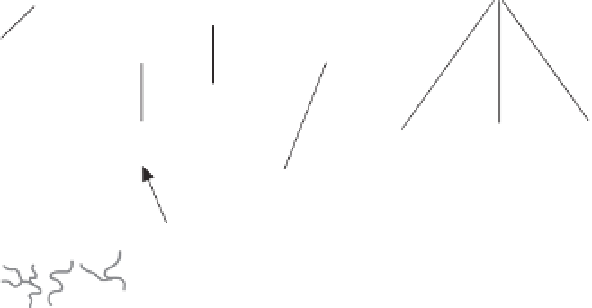Environmental Engineering Reference
In-Depth Information
Figure 19.5
Geomorphological model of a barrier island with its characteristic main units and traits. Values in parentheses
refer to expected longevity of main units (years). (1) Island head with temporal green beaches, (2) old dune and salt marsh
systems disconnected from the beach, (3) wash-over complexes and salt marshes with a wide gradient from high elevation
with fresh water from the dunes to intertidal fl ats with saline water, (4) island tail with young dunes and salt marshes
connected to the beach and intertidal fl ats and (5) beach and foreshore with temporal green beaches. The model represents
the full dynamics and zonation of salt marshes, and is a reference model for restoration. (Modifi ed from Esselink
et al
. 2009 .)
provide more economic value per unit area than most
other ecosystems if tourism, carbon storage and coastal
defence were combined. An attempt is also made to
indicate to which extent these services can be regained
along with salt marsh restoration (Jones
et al
. 2011 ).
The salt marsh harbouring all these conditions fea-
tures (1) tidal inundation with salt water and drainage
of fresh water from the hinterland, (2) zonation of
communities from pioneer zone towards high salt
marsh, (3) suffi cient width from low intertidal fl ats
towards high elevation to include creeks, creek bank
levees and depressions and (4) geomorphological
dynamics (i.e. continuous building of young marsh, or
periodic erosion followed by building of young marsh)
(Esselink
et al
. 2009). Such salt marshes show the
highest richness of characteristic saline and brackish
plant and animal species, and the habitat types and
characteristic plant communities to be protected or
restored in the Natura 2000 system (EUNIS 2006).
This is a supranational instrument providing a
common framework for the conservation of plant and
animal species and their natural habitats within the 27
member states of the European Union. This EUNIS
classifi cation is the basis for the creation of an Euro-
pean network of Special Areas of Conservation, a
major constituent of Natura 2000 (see also Chapter
14). Whereas the EUNIS classifi cation deals with the
' ideal ' vegetation, the ' ideal ' situation or
reference
of
a natural salt marsh, from a
geomorphological
point
of view, is shown in Figure 19.5. Although this repre-
sents a scheme of an island, it can hold for a mainland
marsh when points 1-4 (discussed in this paragraph)
are taken into account.
The 'ideal' system may not be achievable in many
restoration projects. The best option for restoration is
to create variation in abiotic conditions with respect to
inundation and drainage, and allow the plant and
animal species to fi nd their way. However, it is possible
that despite proper tidal inundation, plants may not
establish as a result of too-low sediment redox poten-
tial (Mossmann
et al
. 2011). Other functions of salt
marshes, such as carbon storage and wave attenuation
(Table 19.2), will be fulfi lled both in a homogeneous
and a heterogeneous marsh. There seems to be a con-
tradiction in the fi xed classifi cation of EUNIS and the
dynamics of the geomorphology. Also here, priority
should be given to the dynamic abiotic conditions.
Most plant and animal species will establish, as there














































